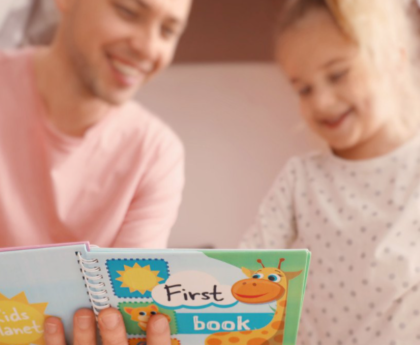Learning to read is a life-changing milestone for children. It opens the door to lifelong learning and can impact academic success. At the foundation of every child’s reading journey is phonics instruction—the method of teaching kids the relationship between spoken language and alphabetical letters.
Whether your child is a pre-reader or on their way to enjoying their first books on their own, here’s what to consider about teaching kids phonics at home.
How is Phonics Taught?
Phonics teaches the relationship between letters and sounds. It involves explicitly (directly) teaching children the correlations between the written symbols (letters) and the spoken sounds (phonemes) they represent.
Through phonics, children learn to decode unfamiliar words by blending the individual sounds together. The ability to decode words is what equips children to begin to read independently!
Explicit and systematic phonics instruction is particularly important because it teaches these letter-sound relationships in a structured, sequential method. Children are introduced to the easiest sound-spelling patterns first and then gradually build their knowledge and skills.
That said, there are several ways in which phonics is taught. Not all of them are equal.
Types of Phonics Instruction
Phonics is widely recognized as an effective approach to teaching reading. However, different types of phonics instruction vary in their methods and efficacy. Understanding each type of phonics can help you understand the approach being used in your child’s classroom. Additionally, it can help you make informed decisions about your child’s reading education.
Analytic Phonics
Analytic phonics instruction, as the name implies, teaches students to “analyze” whole words and then identify sounds and letter patterns within. Children are encouraged to learn familiar vocabulary words and then break them down into their component sounds. For example, a child might first learn the word “cat” in print and then be taught that it consists of the sounds /c/, /a/, and /t/.
Synthetic Phonics
Synthetic phonics instruction takes the opposite approach of analytic phonics. It teaches children to sound out individual letters in a word and then blend those sounds together to form the word.
Children are explicitly taught the sounds associated with each letter or letter combination as a foundation. They then learn to synthesize those sounds to read words. For example, a child might first learn the sounds /c/, /a/, and /t/ and then blend the words in print to form the word “cat.”
Today, synthetic phonics is strongly supported by researchers and reading specialists around the world. It’s a highly effective phonics method that most children can grasp with proper instruction.
Embedded Phonics
Embedded phonics is a literature-based reading method or “whole language” form of instruction. Phonics skills are taught incidentally as children encounter new words in their reading materials. Letter-sound relationships are not taught explicitly or in a structured sequence. Rather, students are encouraged to implicitly learn new words through context.
This approach causes many students to struggle, as they lack a solid foundation of decoding. Plus, it’s unrealistic to rely on context cues or “guessing” as reading skills advance.
Analogy Phonics
Analogy phonics, as a subtype of analytic phonics, teaches children to use parts of words they already know to help them decode unfamiliar words. Children are taught to recognize familiar word families and patterns, and then use those analogies to read new words. For example, if a child knows the word “cat,” they can use that knowledge to read similar words like “bat” or “hat.”
This type of instruction can build on children’s existing knowledge and be engaging for some students. However, it’s not recommended as a primary method of instruction.
How to Help Your Child Learn Phonics
A systematic and synthetic phonics approach has emerged as the most effective method in teaching kids phonics. It’s been backed by extensive research and evidence. Here’s why this method is considered the gold standard for teaching reading.
- It’s explicit and structured. Synthetic phonics instruction should explicitly and systematically teach letter-sound relationships. This systematic approach ensures that children develop a solid understanding of the alphabetic principle and the skills to decode unfamiliar words accurately.
- It’s based on the science of reading. Collections of research from various fields in neuroscience, education, psychology, and speech pathology consistently reveal the efficacy of systematic phonics instruction over other methods. Children who learn using the explicit approach outperform their peers in word reading and spelling skills.
- It’s effective for all learners. Synthetic phonics has been particularly effective for struggling readers—those at risk for reading difficulties and children with learning disabilities like dyslexia. This approach provides a strong foundation for decoding and reading development, which is crucial for students struggling to read.
By teaching children to decode words systematically and accurately, synthetic phonics equips them with the essential skills to become proficient readers. This approach not only fosters reading success but also instills confidence and a lifelong love for reading.
Activities to Help Teach Your Child Phonics and Reading
To strengthen your child’s reading development and understanding of phonics, here are some effective activities to try.
- Sound Sorting: Gather objects or picture cards and have your child sort them based on their initial sounds. This activity helps reinforce the connection between letters and sounds.
- Blending Games: Play games where you provide individual sounds, and your child has to blend them together to form a word. You can use small objects or even your fingers to represent each sound.
- Rhyming Fun: Read rhyming books or play rhyming games to help your child develop phonological awareness, which is crucial for phonics and reading success.
- Decodable Books: Read decodable books with your child. Choose books that align with the letter-sound patterns your child has learned. These books provide practice in applying phonics skills to read simple, controlled texts.
- Word Building: Use letter tiles or magnetic letters to have your child build and manipulate words, reinforcing their understanding of sound-spelling relationships.
When you consistently practice engaging phonics activities with your child, you support their reading development!
Teach Your Child Phonics at Home: Reading.com
Phonics instruction is the foundation of successful literacy development. By understanding and implementing systematic, explicit phonics methods effectively, you set your child on the path to literacy success.
At Reading.com, we provide a proven, research-based approach to phonics and reading instruction. It’s designed for parents to engage directly with their kids as they build the essential skills for early reading! Download the app for a free trial and watch your child improve their phonics skills.





